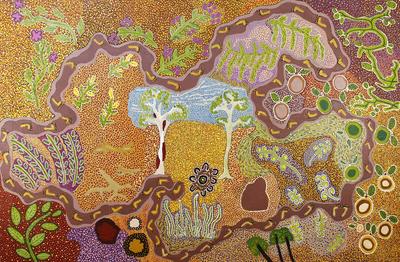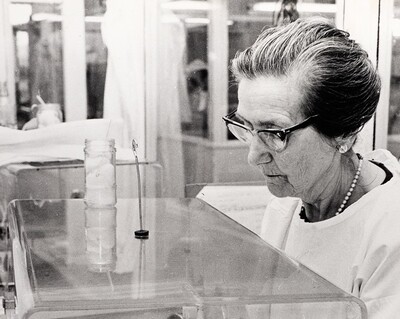Bush medicine: a collaborative work by women from Wirrimanu (Balgo)
Maker
1. Miriam Baadjo (b.1957)
2. Tossie Baadjo (b.1958)
3. Gracie Mosquito (b.1955)
4. Jane Gimme (b.1958)
5. Helen Nagomara (b.1953)
6. Ann Frances Nowee (b.1964)
7. Imelda Yukenbarri (b.1954)
Date
2018
Description
This artwork was commissioned by Dr Jacqueline Healy, Senior Curator, Medical History Museum and Henry Forman Atkinson Dental Museum for the Faculty of Medicine, Dentistry and Health Sciences. It was painted for the exhibition "The art of healing: Australian Indigenous traditional healing practice" and will be part of the permanent collection of the Medical History Museum.
In the centre of the painting are two trees, on the left the Wirrimangulu or Bloodwood tree. The sap from the tree is a powerful medicine boiled in water until melted and drank for any serious ailment including cancer
tumors. Tinjirl (Mulan Tree (River Gum)) grows by the river-side. It has powerful cultural significance and forms part of the seven sisters tjukurrpa for the region. It is used for Law and for smoking ceremony to
cleanse bad spirits. It can also be inhaled for respiratory problems.
The central trees are surrounded by a variety of plants, leaves, fruits, barks, roots and other bush medicines.
The pink flowers on the top left of the painting represent the Karnpirr-Karnpirr plant. The shiny fat leaves are crushed and mixed with animal fat to make a vix type rub to treat children’s colds. To the right are the
Pampilyi (bush Kiwi). The seeds are used to make tea for kidney cleanse. Top centre is the Marnukitji (Konker Berry). The berries are high in antioxidant and vitamin C and the roots are ground and used to make rub for pain relief and have a very good smell. Centre right is the Tjipari (Eucalyptus) leaf for smoking newborn babies. In the right hand corner is the Warrakatji (Bush Vine) that is wrapped around the forehead for relief
of migraine. Down the right side of the painting is the Tjukurru (bush passion fruit) which are boiled along with the leaf of the plant and drank as a medicinal tea for stomach ailment. To the left of these fruits is the
Piriwa (Grevillia) for sweet water. The bark is ground and applied to the skin for treating ringworm and sunburn. Underneath the two central trees is the Ngapurlu-Ngapurlu. Milk from this grass is used for sores
but can also be used for permanent hair removal. To the let the grasses is Piltji (red ochre) used for spiritual healing and ceremony. Above the ochre are the roots and Parntapi (Bark) which are ground, boiled and drunk
for stomach pain. Bark can also be applied to hair to promote hair growth.
Copyright for both painting and text remains with Warlayirti Artists and may not be reproduced without permission.
See full details
Object detail
Nangala
Nangala
Nungarrayi
Napurulla
Nungarrayi
Nakamarra




Do you know something about this object?
Be the first to comment on this object record.